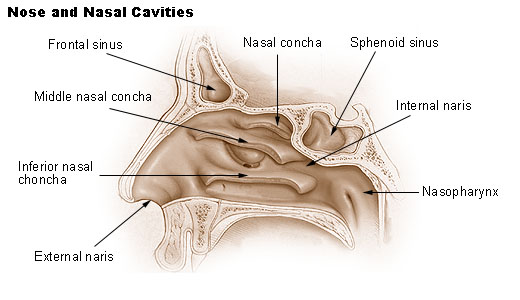
Nasal Cancer Symptoms
Many Patients Overlook Early Symptoms
The American Cancer Society (ACS) states nasal cavity cancers are rare, with roughly 2,000 cases diagnosed in the United States every year. Nasal passage tumors become more common with age, as 4 out of 5 cases occur in patients aged 55 and older. ACS notes men are more likely than women to get nasal cancer. Certain nations, including Japan and South Africa, see significantly higher prevalence of nasal cancer than other countries.
Nasal cancer symptoms are often overlooked because of their similarities to other, more common diseases. Small nasal cavity cancers usually don’t cause specific symptoms making early detection easier. Because of this, ACS says many nasal cancers aren’t detected until they grow large enough to block the nasal airway or sinuses, or until they spread to nearby tissues or metastasize into distant bodily areas.
Nasal cancers often share symptoms with sinus cancers since because of their interconnected nature and close proximity. Symptoms include nasal congestion and stuffiness that doesn’t improve or actually worsens, pain above or below the eyes, blockage on one side of the nose, post-nasal drip into the back of the nose and throat, frequent nosebleeds, pus draining from the nose, decreased sense of smell, numbness or pain in parts of the face, loosening teeth or numbness in the teeth, constant watery eyes, bulging of one eye, loss or change in vision, pain or pressure in one ear, trouble opening the mouth, or enlarged lymph nodes in the neck.
ACS notes having these symptoms does not necessarily mean you have nasal cancer. However, a lack of the above symptoms doesn’t mean you don’t have nasal cancer. It’s important to speak with your doctor to accurately diagnose any symptoms as quickly as possible.
Five-year survival rates published by ACS emphasize the importance of early detection. Statistics from the 7th edition of the American Joint Committee on Cancer staging manual show 63% and 61% of nasal cancer patients diagnosed at Stages 1 and 2 respectively live at least five years after diagnosis. Those five-year survival rates drop to 50% for Stage 3 diagnoses, and 35% for Stage 4 diagnoses.
Survival rates are affected by a patient’s general state of health, exact type and location of the cancer, the treatment modality used and even the patient’s outlook.
Many nasal cancer victims don’t realize their cancer can be caused by occupational or environmental exposures to certain chemicals or substances. Allen Stewart, P.C. has successfully represented cancer victims in lawsuits against companies manufacturing cancer-causing substances to which victims were exposed. If you or a loved one has nasal cancer, contact Allen Stewart P.C. today.
